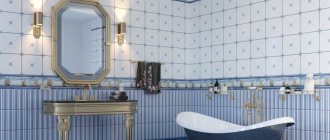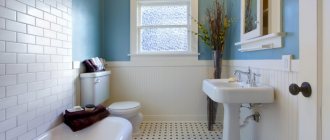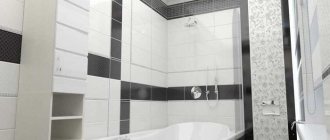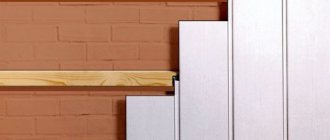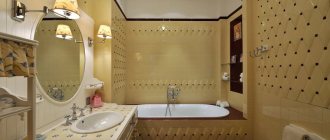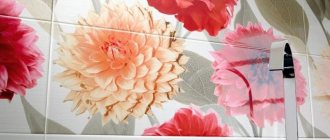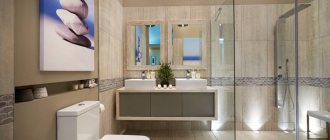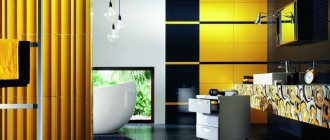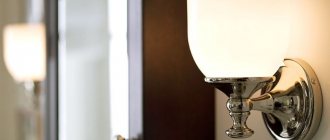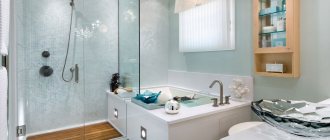Pros and cons of using plastic panels
The main advantage of plastic, in addition to its low cost, is practicality:
- The material is moisture-resistant and does not become stained if drops of water fall on it.
- High-quality plastic does not absorb or emit odors.
- The panels are undemanding in maintenance.
- Repairs in a bathroom with PVC panels are carried out literally in a day, after which the room can be used immediately.
- The installation features of plastic wall structures make it possible to hide utility lines behind them.
- Plastic has a variety of designs and looks impressive in modern-style interiors; it is suitable for the design of a small bathroom.
The disadvantages include:
- Fragility. A strong blow or impact with a sharp object threatens the appearance of cracks or through holes, and when pressed with a finger, dents are easily formed.
- PVC products can hardly be called environmentally friendly, although high-quality plastic does not emit toxins.
- Condensation is inevitable if you use plastic panels in the bathroom. Good ventilation is necessary to prevent mold from appearing on the walls.
Which plastic panels to choose for a classic bathroom design?
The traditional bathroom is kept in a very classic and understated style. If you're afraid to experiment with colors, shapes and patterns, then consider standard solutions that can also be used for a modern style. The word "classic" means creation from a period before the latest discoveries and technologies. Nowadays, this phrase can refer to old, good solutions, modified in a more modern direction. Choose plastic panels for your bathroom in light pastel colors that will never go out of style.
Panels or tiles
The preference for one type of finish over another is associated with certain features of their use.
Advantages of such panels:
- simple, quick installation;
- easy care;
- easy repair;
- efficiency;
- original design.
Advantages of this type of tile:
- better moisture resistance;
- high strength.
Acrylic and aquapanel have good moisture resistance and durability, so tiles are increasingly being ignored when decorating a room.
Varieties
Panels that imitate tiles are different. For example, the most popular polyvinyl chloride models are divided into several types, having different shapes and resistance classes.
According to their shape, PVC panels are divided into two main options.
- Leafy. PVC sheets are easy to install. They are installed on the bases using an adhesive composition. Visually they are very similar to plywood.
- Square details. These materials have a clear, strict form. The design here can be varied. The layout is carried out alternating different shades or an original pattern is created.
Polyvinyl chloride tiles, in turn, may vary depending on the type of fastening provided.
- With lock type connection. Such materials are installed using tongue-and-groove connections. Before installing such products, you have to resort to preparatory work.
- Popular options are those that are attached to bases with adhesive compounds. Here, a special glue is used, which is applied to the back surface of the panels, after which they are pressed to the base and rolled with a roller.
- There is a large assortment of self-adhesive panels/tiles . One side is adhesive and covered with a paper layer. To install these materials, you do not need to purchase additional products or adhesive solutions. It is enough to remove the layer of paper from the part and apply it to the base. In most cases, these options are used if you need to add interesting decorative elements to your decor.
Bathroom panels vary in design. On sale you can find models for tiles in a variety of colors and shades. It is possible to choose both light and dark, both matte and shiny options - there are a lot of solutions.
How to choose the right one
There are several important rules that will help you buy PVC panels for the bathroom:
For high strength of the material, it is necessary to select panels with a large number of jumpers. The more stiffening ribs, the less possibility of the panel breaking. And be sure to check each individual part for defects.
Pay attention to the appearance and design features of the material. On high-quality products, the decorative coating is applied with high precision and without flaws.
Try to connect the two parts; there should be no gaps between them in the locking system.
If the tile does not correspond to the size stated on it, you should think about whether to buy this product. It is possible that all products will not be of adequate quality and other difficulties may be encountered during the installation process.
Basic recommendations
- For a small bathroom, it is appropriate to choose light shades, thus increasing the visual volume of the room;
- An interesting solution is the arrangement of plastic panels of different sizes and designs. For example, you can combine contrasting tones;
- The wooden texture will allow you to decorate the room in an ethno style;
- You should not combine polyvinyl chloride cladding with expensive materials, such as marble. In this case, the interior will turn out tasteless;
- If desired, you can choose plastic panels for tiles. Thus, the decoration of the bathroom can be done in a classic or neoclassical version - with columns, friezes and borders;
- Photo printing allows you to create an individual design, thanks to modern paint application technologies;
- Sheathed walls go well with slatted ceilings.
Dimensions
If the room has a non-standard height or layout, you need to pay special attention to these parameters. The length of the panels is usually 2.5–3 m. If you need to cover only the upper or lower part of the wall with them, you can select the elements so that a minimum of waste is left when cutting. The thickness of the products is usually 5–12 mm, and the width ranges from 100 to 500 mm. For a bathroom, it is better to choose the widest ones: the fewer joints, the less likely it is that moisture will accumulate in the seams. But if the room is small or has a non-standard shape, in order to save money, it is more advisable to choose narrow stripes. Calculating their number is simple: the length of each wall must be divided by the width of the selected panel. It is better to consider the element to be cut as a whole, without planning to use the remaining part elsewhere.
Plastic panels - what are they?
The bathroom is an aggressive environment, so special materials with the following characteristics must be used to decorate it:
- Keep moisture out. Caused by direct water contact with the walls.
- Environmentally friendly. During bath procedures, the temperature in the room rises and steam is formed. Under such conditions, the finishing material should not emit harmful fumes and odors.
- Sanitary safety. The cladding should be easy to clean and resistant to fungus.
- Easy to care for. The bathroom is an aggressive environment, so the surface should be cleaned without unnecessary effort.
Plastic panels for the bathroom have all these qualities. This material is made from polyvinyl chloride, a material that is safe for human health. Depending on the manufacturer, the length can be from 2700 to 6000 mm, width - from 100 to 300 mm.
A wide range allows you to choose the appropriate option for any design project. This could be a drawing, mirror sheets, imitation lining, plastic panels for bathroom tiles, the photos presented in our article clearly prove this.
It is worth taking a closer look at the advantages of such material.
Installation methods
Today, there are several methods for installing PVC panels, with the most widely used being installation on lathing. The frame structure is assembled from metal profiles, plastic or wooden beams. If wood is chosen for the sheathing, it should be treated with antiseptic agents in advance. Standard metal profiles are usually used for the frame, and the size of wooden and plastic beams should not be less than 4x2.5 cm. They are attached to the wall and ceiling with screws, observing a step of 40 cm.
The sheathing strips must be fixed perpendicular to the direction of placement of the panels. Moreover, regardless of whether it is a suspended ceiling, a panel or a screen, the cladding can be carried out both vertically and horizontally. The choice usually depends on the features of the room and style. But it is worth noting that vertical installation has its advantages. It ensures unimpeded flow of water downwards. This is especially important when covering a shower stall. As for the vertical installation, it contributes to the visual “sliding” of the walls.
When assembling the sheathing, the structure should be additionally strengthened at the corners with supports, for which small sections of panels are used.
The installation process is as follows:
- Finishing begins from one of the corners of the room or from the door. First of all, fix the starting corner; it is attached to the surface with staples or nails. Then, using a fastening system, the first panel is installed, which is nailed to the frame.
- The next step is to install the second panel; it is placed adjacent to the first and thus the cladding is continued to the next corner.
- At the end of the covering, the finishing corner is attached and the final panel is inserted into it. The joints between the elements are carefully coated with sealant and installation of ceiling or floor plinths begins.
No less popular is the installation of PVC on special fastening clips; for this, a durable frame is first made. In cases where there are significant unevenness on the surfaces, plastic or plywood gaskets are placed under the planks and profiles and secured with self-tapping screws. Similar to the first method, the inner corner is secured with clips near the door or in one of the corners, after which the first plate is inserted into the profile. Then a second one is placed in its groove and secured with clips. Then everything continues according to the previously described scheme.
If the bathroom is small, then frame installation is considered not the best option , since the design reduces the usable area of the room. Therefore, for small bathrooms, panels are most often installed frameless, using glue. The only disadvantage of this technology is that it requires a perfectly flat surface, so the ceiling and walls have to be well prepared for covering. To secure the material, you should purchase special adhesive mixtures that do not contain organic solvents, as they have a detrimental effect on the plastic. A suitable means for this is “liquid nails”; no more than one can of them is required per 5 m2.
Installation of panels with glue is carried out in several stages:
- First of all, dry the working base well using a heat gun or a hair dryer. Then the surface is primed with an antiseptic.
- After this, the walls and ceiling should be leveled so that differences do not exceed 3 mm. The presence of minor tubercles and cavities is allowed; they can be easily cut off with a grinder. Great attention is paid to the joints in the corners. They must be strictly perpendicular, otherwise the installation work will become more complicated, creating problems with fastening the initial and finishing strips of the frame.
- When the base for finishing is ready, apply glue to the panel, leaving a small distance from the edge, and apply it to the surface level, pressing for 5 minutes until the adhesive mixture sets. Sheathing elements that are adjacent to the floor and ceiling are cut, fastened with dowels and decorated with baseboards.
Installation subtleties
Covering bathroom walls with panels can be done in two ways. In the first case, a frame made of wooden slats with a cross-section of 1x3 cm is installed on the wall, on top of which panels are mounted. The frame is attached to the wall using dowels, and the panels themselves are attached to the sheathing using nails or a construction stapler. The correct installation of each lamella is controlled by a level and, if necessary, a gasket is placed.
The gap between the panel and the floor (ceiling) should be 1 cm. Upon completion of the installation of the last element, the corner joints are closed with corners, the gaps near the door slopes - with end moldings, and the cracks near the floor and ceiling - with special skirting boards. When installing the sheathing, you need to remember that when the lamellas are placed horizontally, the sheathing slats are attached vertically and vice versa.
The second method involves installing panels directly on the walls and requires preliminary leveling and priming of the working surfaces. The gluing of elements should begin from the corners, which in the future will eliminate the need for complex adjustment of corner elements. The installation of the first lamella is carried out with a distance of 1 cm from the ceiling, floor and adjacent wall. This panel will serve as a guide for further installation. The glue is applied to the panel in the form of a thin zigzag every 50 mm of the lamella width. Accidentally formed chips and potholes larger than 2 mm are filled with cement mortar, puttied and sanded.
After the last element is installed in place, the joints are closed using moldings and baseboards.
Installation Features
In order to attach models of various sizes to bathroom walls, no special skills or abilities are required. By and large, the installation of wall MDF is very simple, but it has its own nuances. Many panels are attached to the sheathing, which greatly simplifies the installation process. In addition, if the walls of the shower room are smooth, then finishing can be done without prior preparation.
Installation on the sheathing
However, if there are defects in the wall surface, they must be corrected. The wall should be primed, plastered, or gypsum board blocks used. The latter option allows you not only to level the surface, but also to create a new one. After preparation, you need to take measurements of the room. In addition, it is necessary to let the moisture-resistant panels sit for several days in the bathroom. This will allow them to acclimatize and get used to new conditions.
Leveling the wall with plasterboard
After which they will acquire qualities that correspond to the temperature regime of the shower room, as well as the level of humidity. It is best to attach sheet panels of various sizes to the wall using a special frame - sheathing. This makes it possible to connect communications, for example, wiring for lighting. This method is suitable for coatings with small defects that need to be hidden. Wall MDF is mounted using self-tapping screws, special brackets, clips or nails.
Installation is carried out starting from the corner of the moisture-resistant product. It is worth knowing that a smaller hole will be better in terms of subsequent operation. In addition, if you get tired of the lathing option, then after some time you can remove it without unnecessary problems. This is suitable for people who like frequent changes of interior style in the bathroom. It is worth noting separately that the installation of wall panels can be carried out both on a frame with a metal base, and on a structure with another material.
Sequence of stages of wall cladding
Getting started - removing all disturbing things from the room so that there is free access to surfaces.
Cool and very fashionable bathroom interior
- Measuring the height of the walls.
- Trimming metal profiles to the required height.
- Installation of vertical profiles at a distance of 50 cm from each other, starting from the left side.
- Screwing fasteners at a distance of 40 cm at the same level, starting from the bottom.
- Gaps of 3-3.5 mm are left between the wall and the ceiling, the wall and the floor.
Delicate and very soft bathroom interior
The result is a strong frame - the foundation. Then the cells are filled with foam.
After laying it, lighting wiring will be done - sockets, places for lamps. The last stage is attaching the plastic panels to the profile with a tight connection of the fragments, gluing the baseboards on top and bottom.
To install the panels, self-tapping screws, screws or nails are used. The panels can be secured using clamps that “fasten” the elements to the sheathing. They allow faster installation, but are more expensive.
For bathrooms, horizontal installation is not recommended, because moisture can easily get into the joints, and then penetrate into the space under the slats and provoke the formation of mold.
In small rooms, using a frame for finishing “eats up” precious centimeters of space. But this is not a reason to refuse this option of decorating with plastic. They can be glued.
Relaxed bathroom interior reminiscent of Chinese style
It’s just that in this case it will be problematic to replace the damaged element. It will not be possible to install built-in lamps or insulate the room.
Enclosed in a large space, the bathroom creates a warm and special comfort
Bath ceiling made of plastic panels
For rooms with high humidity, plastic panels are the ideal solution. And first of all, installing such finishing is important on the ceiling. Experts say that this method is the best solution for surfaces in the bathroom and kitchen where there is a high level of humidity.
Good to know! The choice of PVC panels for ceiling decoration is explained by the many advantages of this material. It is moisture resistant, easy to install and maintain, and has a low risk of further deformation. But the decisive factor is the relatively low price. In the end, the affordable cost of good material means that you should opt for it.
From a huge variety of plastic panels for walls and ceilings, choose those that are ideal for your bathroom.
Design ideas
In this section we will look at the various possibilities for decorating a bathroom with PVC panels. It is worth noting that the choice of light colors will significantly increase the space at the visual level. If you lay the lamellas on the walls vertically, the room will appear taller, and if horizontally, it will appear wider. The beauty of decorating bathroom walls with plastic panels will be successfully emphasized by a mirror or slatted ceiling, creating the effect of a stylish environment.
Plastic panels with a pattern
A monochromatic bathroom design may seem boring, especially when the room is quite spacious. In this case, drawings will come to the rescue, adding variety to a boring environment and taking part in zoning. The design on the panel can be applied with paints or using the modern photo printing method. You can use paintings to decorate the wall above the font, sink, or create real masterpieces called murals.
Imitation of ceramic cladding
Manufacturers offer a large selection of materials that accurately imitate a wide variety of tiles. Such plastic panels reproduce not only traditional installation, but also cladding with friezes, borders, etc. You can choose a very impressive decor that will be visually difficult to distinguish from real cladding.
Photo printing on polyvinyl chloride
Marine style cladding.
Imitation of wood and decorative stone
Panels designed to resemble wood will be an excellent option for decorating a rustic-style bathroom. The overall picture can be complemented by rough wooden furniture, combined with cotton curtains with floral patterns. PVC panels with imitation bamboo will perfectly fit into the ethnic style.
Imitation of decorative stone is typical for luxurious interiors. The pattern can imitate various types of natural stones: malachite, marble, topaz and others, while having a smooth or embossed surface. This design is often used for classic-style bathrooms.
Black and white bathroom design
The combination of black and white has always been considered a win-win. But for this duet to really look elegant and harmonious, it is important to achieve the correct dosage of these colors. After all, the slightest mistake can upset the balance, making the interior tasteless and depressing.
Black and white paneled bathroom
The black and white combination is not suitable for those who want to decorate a room in a country, Provence, boho or shabby chic style. But it will be an ideal option for modern, loft, minimalism or retro styles.
What to look for when decorating a bathroom with black and white plastic panels:
- It doesn’t matter which color is chosen as the dominant one, the principle of alternation will make the room harmonious. For example, there should be something dark on a perfectly white wall. This could be a sconce, a shelf, or partial use of material of the opposite color.
- If you use these two colors in equal proportions, you can get an unnatural effect. Therefore, black and white should always be used disproportionately.
- To prevent the surface from merging into one spot without contours, designers recommend combining glossy and matte surfaces. For example, if the wall is decorated with matte plastic, then you should choose glossy accessories and vice versa.
Decorating the bathroom with plastic panels in black and white colors
Finish style
The bathroom can be decorated in different directions. This largely depends on preferences, room size, and professional advice. Let's look at the most popular bathroom design options.
Sea style
In this direction, designers recommend using panels of natural shades. The bathrooms look light and rich in detail. When creating in this style, plastic panels alone will not do. The entire interior is complemented with various elements. Paintings and images depicting the sea, shore, and starfish will fit perfectly into the interior of the bathroom. Large format mirrors will visually add volume to the space, and small shells, pebbles and sand in vases will harmoniously complement the overall picture.
Design: Sergey Ogurtsov
Modern
Art Nouveau style is all about free space and the absence of unnecessary things. The entire decor is distinguished by its creative creation of a full-fledged zoned space. Walls with ceilings are installed at different levels. Many lamps, lamps and lighting elements are built in. In the design of a bathroom in the Art Nouveau style, plastic PVC panels in light colors are used.
Design: Anna Clark
Minimalism
Glass, metal and the absence of unnecessary things - this is exactly what designers call for when decorating a bath in this style. Plastic panels will create the desired range, atmosphere, and visually expand. Therefore, PVC material is actively used.
Country
To implement this style, professional decorators recommend using imitation natural wood. The choice of PVC panels allows you to implement this idea using a minimum of time. Simple wooden furniture, a small chandelier without unnecessary decorations will complement the chosen style.
Provence
Provence style is easy to fit into the bath. Using a PVC panel in light, pastel shades. Simple components and light furniture should not weigh down the space. You can complement such a bath with patterns, floral prints and porcelain details.
Main advantages of use
The installation process will not require any special professional skills from you, which can be completed without the help of expensive specialists. It is worth noting the financial component of consumables, which will cost you an order of magnitude lower than when installing tiles.
Plastic panels perform well when used in a humid environment. Even with long periods of use they will retain their original appearance.
Loft-style bathroom: tips, ideas and best design ideas (70+ photos)
With proper installation, with their help, it is possible to hide all visual unevenness of the wall, such as pits, waviness or swelling. Among other things, it is possible to hide water communications.
Having a lot of advantages, they are inferior to tile coverings in terms of service life. Another difference is that the tiles are made from natural materials, which means they are more environmentally friendly. There are many options for finishing a bathroom with plastic panels.
Photo of finishing a bathroom with plastic panels
Bathroom tiles - photos of the best bathroom design ideas (115 ideas)
Sources- https://bathroom-design.su/idei/otdelka-vannoj-plastikovymi-panelyami/
- https://VannayaSovety.ru/nastennaya-otdelka/paneli-dlya-vannoj.html
- https://vplate.ru/vannaya-komnata/paneli-pod-plitku/
- https://dizajninterera.org/paneli-pvx-dlya-vannoj/
- https://v-vannoy.com/77-otdelka-vannoy-komnaty-plastikovymi-panelyami-30-foto.html
- https://www.obi.ru/sovety/building/walls-and-floors/pvc_panels_for_bathroom/
- https://dekoriko.ru/paneli-pvh/dlya-vannoj/
- https://vplate.ru/vannaya-komnata/stenovye-paneli/
- https://sovety-vannoy.ru/delaem-remont/steny/vlagostojkie-paneli-mdf-dlya-vannoj.html
- https://modernplace.ru/dekor-vannoi-panelyami/
- https://Trizio.ru/plastikovye-paneli-dlya-vannoy-85-foto-931
- https://www.ujut-v-dome.ru/plastikovye-paneli-dlya-vannoj-60-foto-reshenij-i-6-luchshix-dizajn-idej/
- https://m-strana.ru/design/plastikovye-paneli-v-oformlenii-vannoy-komnaty-foto-idei-dizayna/
- https://www.InMyRoom.ru/posts/15858-otdelka-vannoj-komnaty-plastikovymi-panelyami-foto-variantov-dizajna
- https://mirdizajna.ru/otdelka-vannoj-komnaty-plastikovymi-panelyami/
- https://dizainexpert.ru/sanuzel/dizajn-vannoj-komnaty-otdelka-sten-panelyami-pvx/
[collapse]
